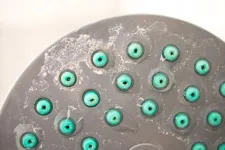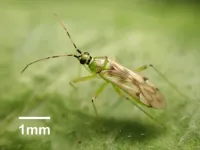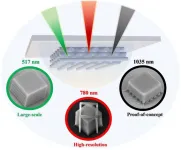(Press-News.org) Plant-based diets, compassionate agriculture, Indigenous methods, consumer pressure, new laws, international agreements and even vegan pets – these are the solutions for fixing our broken food and farming systems, say dozens of environmental advocates, researchers, farmers and industry pioneers in a new book.
Editors Joyce D’Silva and Carol McKenna sound the alarm in their introduction to Regenerative Farming and Sustainable Diets, warning that ‘our food system is broken’. Radical change is needed, they say, in our world where one‑third of food is lost or wasted, 780 million people are hungry, and three billion people cannot afford to eat healthily.
In this context, eminent researcher and author Philip Lymbery argues for an overarching UN Global Agreement to transform food systems. He warns: “We have just sixty harvests left in our soils to save the future for our children. For people, animals and the planet, the clock is ticking. There is no time to lose. What we do now will define the next one thousand years.”
In his chapter, scientist Tim Benton illuminates how increased meat consumption has been a major driver of our planetary crisis: “As demand has risen – partly because of a growing global population but mainly owing to increased meat consumption and the associated increase in demand for animal feed – so too has the use of chemical inputs such as fertiliser, pesticides and herbicides to maximise yields on existing cropland… Nature has suffered as a result. Food production is therefore a central cause of declining biodiversity, deforestation, water and air pollution and land degradation.”
But far from simply tolling a klaxon of doom, the authors of the book’s chapters elicit hope by offering solutions for feeding the world, while nourishing our soils and protecting our species.
UK dairy farmer David Finlay charts his own path away from intensive agriculture and towards compassionate farming. Within just eight years, he has created a system which: produces bountiful milk, sees calves stay with their mothers and reach mature weight sooner, feeds cattle on leafy forage instead of mass-produced cereals, boosts farm biodiversity and has become ‘climate positive’.
Indian scholar Vandana Shiva invites us to learn from the Indigenous peoples who protect 80% of the planet’s biodiversity by looking after the 22% of the land still under their stewardship. She says: “We can bridge the climate change emissions gap through ecological agriculture now, not at some point in the future. Even if only 10% of farms and pastures are managed regeneratively by maximising photosynthesis and root exudates, we can mitigate emissions by fixing more living carbon in plants and building up carbon in soil. The solution to hunger extinction and the climate emergency is to return to Earth and regenerate her biodiversity in soils, our farms, forests, our diets and our guts.”
British haematologist Shireen Kassam evidences the way plant-based diets boost both human and planetary health. She cites the EAT‑Lancet planetary health diet which suggests humans derive more than 85% of their energy from healthy plant foods. Such an approach has been shown to reduce deaths from all causes by more than 60% and reduce cancer rates by up to 40%.
But perhaps it’s not just humans who should eat plant-based diets. In his chapter, researcher Andrew Knight argues for feeding cats and dogs a vegan diet. He says that the production of pet food contributes over a quarter of the livestock sector’s environmental impact. And he calculates that if all of the world’s cats and dogs were vegan “nearly seven billion fewer vertebrates would be killed”.
Indeed, Knight presents evidence that if all the pet dogs in the world were vegan, it would save enough food to feed the entire population of the EU. And if all pet cats were vegan, it would save the same amount of greenhouse gas emissions as the whole of New Zealand emits.
But can our naturally carnivorous canine and feline housemates really lead healthy lives as vegans? Knight argues yes. He cites studies which have demonstrated that dogs and cats who are fed nutritionally-sound vegan diets have health at least as good, and in some respects better than, those fed meat‑based diets.
And while the various chapter authors largely sing in unison over the way forward, some strike different notes about which groups are best placed to bring about change.
Leon co-founder Henry Dimbleby - who has led two independent reviews for government – argues that we cannot rely on shoppers or farmers to drive change. Instead, he calls on governments to step up:
“We need new legislation to improve the lives of farm animals – a continuous ratcheting up of the standards we expect for factory farmed animals to relieve the cruelty we inflict upon them. It’s no good expecting food producers or retailers to act voluntarily: the commercial incentives to produce cheap meat are simply too strong. Nor can we rely on consumer pressure. Although animal welfare ranks high amongst consumer concerns, most people have neither the time nor the information necessary to trace the provenance of all the meat they buy.”
But the executive director of Waitrose, James Bailey, who nods approvingly to Dimbleby’s work in his chapter, seems to disagree with him on this particular issue. Instead, he points at customers:
“Revolutionary change will only happen when it is demanded by shoppers. We need customers who understand what is at stake, willing to buy food produced in more sustainable ways that will probably be a bit more expensive. The reason that vegan food has quadrupled in shelf space in the last five years in the UK isn’t because supermarket priorities have changed. It’s because customer priorities have changed.”
In her chapter, Lyla June Johnson, an expert in Indigenous food systems, urges us to learn from traditional methods, inspiring us to step up to the challenge:
“We do not need to settle for tiny orchards, nor do we have to simply let nature take its course. We can be active agents and participants in the way the land looks and tastes on massive, regional scales. Perhaps this signals to us as humans that we indeed have an ecological purpose in this world if we simply wield our energy in a regenerative manner.”
END
Our food system is broken and we only have 60 harvests left, researchers warn
2024-10-09
ELSE PRESS RELEASES FROM THIS DATE:
Viruses are teeming on your toothbrush, showerhead
2024-10-09
Step aside tropical rainforests and coral reefs — the latest hotspot to offer awe-inspiring biodiversity lies no further than your bathroom.
In a new Northwestern University-led study, microbiologists found that showerheads and toothbrushes are teeming with an extremely diverse collection of viruses — most of which have never been seen before.
Although this might sound ominous, the good news is these viruses don’t target people. They target bacteria.
The microorganisms collected in the study are bacteriophage, or “phage,” a type of virus that infects and replicates inside of bacteria. Although researchers know little about them, phage recently ...
Can weight-loss surgery help prevent pancreatic cancer in people with obesity?
2024-10-09
Obesity and type 2 diabetes are risk factors for various malignancies, including pancreatic cancer, which has a high death rate. A new analysis in Diabetes/Metabolism Research and Reviews suggests that weight-loss surgery—also called metabolic-bariatric surgery—may lower the risk of developing pancreatic cancer in people with obesity, especially in those who also have type 2 diabetes.
In the systematic review and meta-analysis, investigators identified 12 relevant studies that explored the effects of metabolic-bariatric surgery on pancreatic cancer incidence, with a total of 3,711,243 adults ...
Octopus-inspired adhesive works well in wet conditions
2024-10-09
In research published in Advanced Science, investigators drew inspiration from the octopus to develop an adhesive that achieves strong attachment and controlled release on varied substrates in wet and underwater environments. The feat could have numerous applications in fields ranging from healthcare and underwater robotics to infrastructure repair.
By studying the octopus’s suckers—specifically, the exposed disc-like portion called the infundibulum—the researchers designed an elastic, curved stalk with a membrane that can change its shape ...
Can adrenaline auto-injectors prevent fatal anaphylaxis?
2024-10-09
Individuals at risk of anaphylaxis—an acute systemic hypersensitivity reaction to an allergen or trigger, typically associated with skin reactions, nausea/vomiting, difficulty breathing, and shock—are often prescribed adrenaline (epinephrine) autoinjectors such as EpiPens. A recent review published in Clinical & Experimental Allergy finds that these autoinjectors, which people use to self-administer adrenaline into the muscle, can deliver high doses of adrenaline into the blood, but these levels are short-lived and may not be sufficient to save lives in cases of fatal anaphylaxis.
Investigators noted that data from animal and human studies ...
Insects from the bodies of illegally hunted rhinoceros may provide valuable forensic information
2024-10-09
New research in Medical and Veterinary Entomology reveals that when rhinoceros are found dead after being illegally killed by poachers, analyzing insects on the decomposing body aids in estimating the time since death. This information has been used by investigators and officials to construct cases against suspected perpetrators.
The study included 19 rhinoceros that were illegally killed and dehorned in the Republic of South Africa between 2014 and 2021. Scientists collected 74 samples of insect evidence from these rhinoceros remains, ...
Does outdoor play help protect toddlers against later childhood obesity?
2024-10-09
New research published in Acta Paediatrica suggests that children who engage in outdoor play during their preschool years have a lower risk of developing obesity later in childhood.
The study included children born in Japan during two weeks in January and July 2001. Of 53,575 children born, 42,812 had data on outdoor play habits at age 2.5 years. In a survey, parents were asked, “Where do your children usually play (excluding home residences and daycare centers attended)?” Available options for answers included “in my garden or on the grounds of my apartment complex,” “in parks,” “in natural areas such as ...
Caffeine is a heart-healthy habit
2024-10-09
A new paper in Rheumatology, published by Oxford University Press, finds that consuming more caffeine may improve heart health.
Vascular disease, damage of blood vessels, and their resulting consequences, heart attack and stroke, are among the leading causes of death in the general population. In patients with inflammatory rheumatic diseases, such as lupus and rheumatoid arthritis, these risks are even much higher. This is both due to the diseases themselves and some of the treatments for them, particularly cortisone derivatives.
Until ...
Symbiotic bacterium Rickettsia affects the reproduction of a predatory insect, an effective biological control agent for agricultural pests
2024-10-09
Many insects are naturally infected with symbiotic bacteria, which are typically transmitted vertically from mother to offspring but are not transmitted horizontally. Understanding the effects of these symbionts is important in terms of insect pest management as they can significantly affect the biology and reproduction of insects. The predatory mirid bug, Nesidiocoris tenuis, which preys on agricultural pests such as whiteflies and thrips, is an important biological control agent. Although the symbiotic bacterium Rickettsia is often found in N. tenuis, its effects on the host have not been clarified.
A research team led by NARO and the University of Miyazaki has revealed that Rickettsia ...
Wavelength-independent and photoinitiator-free laser 3D nanolithography
2024-10-09
Laser direct writing (LDW) employing multi-photon 3D polymerisation is a scientific and industrial lithography tool used in various fields such as micro-optics, medicine, metamaterials, programmable materials, etc., due to the fusion of high-throughput and fine features down to hundreds of nm. Some limitations of technology applicability emerge from photo-resin properties as any material modifications can strongly affect its printability due to applied photoexcitation conditions.
In a paper published at Light: Advanced Manufacturing, a team of scientists, led by Professor Mangirdas Malinauskas from Laser Research Center at Vilnius University, Vilnius, Lithuania, coworkers ...
Duke-NUS alumnus and mentor develop new precision tool to better predict outcomes for patients with liver cancer
2024-10-09
Duke-NUS alumnus Dr Marjorie Hoang (Class of 2023) and her mentor, Professor Pierce Chow, have brought clarity to the complex decision-making process patients diagnosed with intermediate-stage liver cancer and their doctors face by creating an algorithm that can accurately calculate the likely overall survival and recurrence-free survival following surgery.
Dr Hoang, whose interest in the liver stems from her first year at Duke-NUS, undertook a transformative third-year research project under the guidance of Prof Chow, a senior consultant specialising in liver cancer surgery at the National Cancer Centre ...



